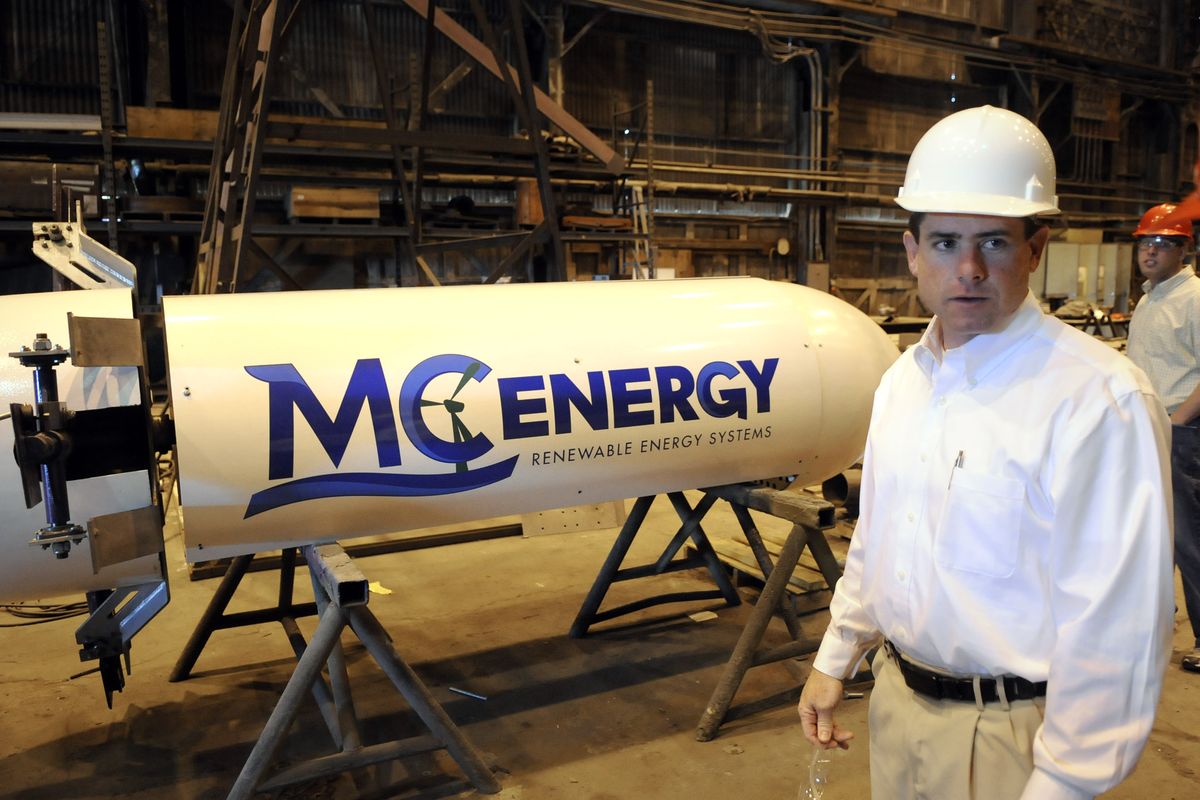Windmill manufacturer builds small-town niche

A hilltop south of Spokane Valley near Mica boasts a 360-degree view of lush countryside, and what landowner Mark Folsom said may be the future of wind energy.
His company, MC Energy LLC, has nailed a 50-foot tower onto the site and topped it with a 15-kilowatt windmill that starts spinning in winds 4 miles per hour, and does not stop no matter how hard it blows.
The machine is sized for a home or small business. Unlike its giant brethren on Washington ridgelines from Vantage to Walla Walla, it does not include gearboxes or other expensive components.
Folsom said the MC turbines are “downwind,” meaning the rotors are in the back. In strong winds, the three blades fold into a shape like a badminton shuttlecock, all while maintaining an optimal rotation of 150 revolutions per minute, he said.
And no electronic controls are necessary, Folsom added. Centrifugal force alone regulates the blade angle.
The windmills were designed to solve another problem for Folsom: how to develop a proprietary product for The Factory Company, which he purchased in 2008, to expand away from a reliance on contract manufacturing for other companies.
The Factory Company is one-half of what was once RAHCO, the updated name of a seminal Spokane industrial company, R.A. Hanson Co.
Folsom bought RAHCO’s machinery, and leases the complex on Magnesium Road where its namesake once built equipment for lining irrigation canals, dredges, and huge conveyors for the mining industry. The complex includes a voluminous World War II-era building where magnesium was produced for use at the nearby Mead aluminum smelter, two smaller, newer manufacturing buildings, and a small office building.
The Factory Company — a name Folsom said he dislikes but has not had the time to change — focuses on manufacturing. Products include small graders and forklifts sold under its hMach brand, and the self-leveling combine, the invention that launched Ray Hanson’s career.
Folsom said his company still modifies the axles and other components of about 10 John Deere combines each year.
But contract manufacturing started to slow down just as Folsom bought the company, and business has not been what he projected.
“We’ve had a tough couple of years,” he said.
Recently, though, old customers are coming back, and the company has found new ones in the aerospace and oil and gas industries, Folsom said. The company recently made a test stand for a Boeing 747 component, he said.
Many of those customers do not want competitors to know what they are up to, he said, adding “This is kind of their secret location.”
Folsom said the company also made two “truck flippers” that hydraulically lift trailers off the ground and spin them, rotisserie-like, for cleaning.
“We’re busier than we’ve been in the last two years,” Folsom said.
Employment, once as low as 35, has increased to 55, although several were hired through agencies. He said he expects to add more.
Folsom grew up in the manufacturing business. His father, Terry, founded Folsom Manufacturing in Spokane Valley. Folsom now owns the maker of components for wood stoves and steam-cleaning towers.
Folsom is also a vice president and partner in Full Throttle Inc., which designs and assembles after-market parts for ATVs and snowmobiles.
“My background has always been steel fabrication,” he said.
With bidding for manufacturing work so competitive, Folsom said he was looking for a product designed in-house that would generate more profits.
The windmill was boot-strapped from the outset, starting with ideas sketched on a napkin with Curt Higgins, MC vice president of research and development.
Initial testing of the design was done in the former magnesium plant, where a giant fan was fashioned out of helicopter blades.
“We could create a hurricane in here,” Higgins said.
Felts Field was next. The windmill was mounted on a trailer and dragged up and down the runway by a truck stuffed with instruments tracking its performance.
“It was amazing how you can simulate wind behind a truck,” Higgins said.
“It’s worked better than we even engineered it,” Folsom said. “Wind, we find out, is a very strange substance.”
Marketing Director Cory Arnold said MC windmills will work in 10 mph to 12 mph winds like those that blow across the Palouse. Utility-scale units need at least 17 mph.
Assuming a constant 10 mph wind, the 15-kilowatt turbine pays for itself in 12 years, he said, but delivers positive cash flow after seven years. Wind power incentives offered by Avista Utilities and the state of Washington help assure payback, he said.
Folsom said the returns will improve if key components made out of state can be sourced within Washington. MC is talking to a Yakima company about making blades now purchased out of Texas, he said.
MC sold its sixth windmill last week. Most buyers have lived in rural areas, and Folsom said farmers will be a significant market for the company. He said a Friday seminar on wind power co-sponsored by Avista, Northwest Farm Credit Services and the American Wind Energy Association attracted about 100 registrants.
Arnold said MC has moved slowly because executives expect sales to take off once in the hands of experienced wind machine dealers. They will sell the machines, but MC will take responsibility for installation so it can maintain quality, he said.
Folsom said The Factory Company can make one windmill a week, but plans to increase output to one a day. Although he wants the machines made in Spokane, he said sales could justify plants elsewhere.
He said the machine near Mica has already become a landmark. When the machine is lowered to the ground for repairs — another unique feature — the phone starts ringing, he said.
“It has turned into an icon out there,” Folsom said.